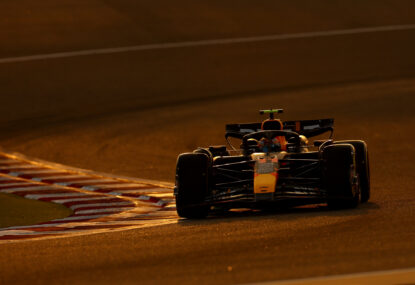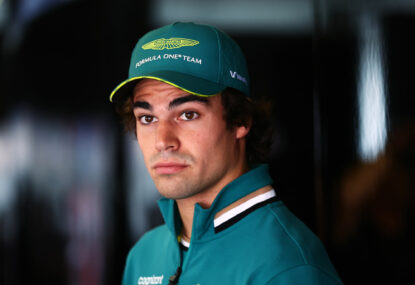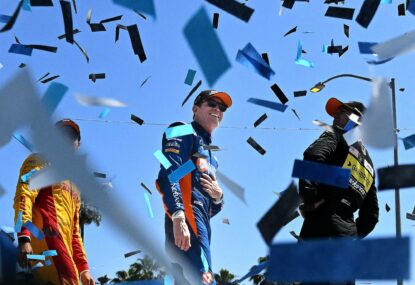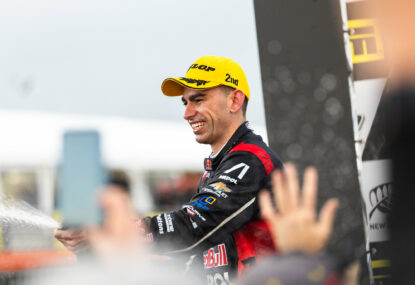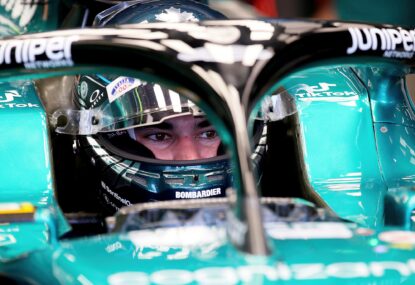It took watching the Valencia MotoGP last night for the loss of Marco Simoncelli, killed at the preceding Malaysian Grand Prix, to really sink in.
The difficulty in accepting Simoncelli’s death comes from many quarters. The finality of death never ceases to shock most – here one minute, gone forever the next. But at only 24 years of age, he was far, far too young for someone with so much to give, in his racing career and beyond, to leave us so soon.
Then there’s the struggle to accept that nothing could be done to prevent the fatal accident – Simoncelli fatally struck by two following riders (tragically, one his hero and mentor, Valentino Rossi) following a fall in Malaysia, for those who weren’t aware.
Many MotoGP riders used the words “freak accident” when describing Simoncelli’s fatal fall; a way to convince themselves that they should go on and of the unlikelihood of a similar fate for them, no doubt. But such accidents are now the most common ways for riders to go, given the huge improvement in track safety.
Such bike-to-body hits at those speeds at those wrong angles will lead to fatalities. It’s a sad reality the sport lives with – unpreventable, barring the invention of some technology that can protect riders from such high-speed impacts while maintaining mobility. They can’t ride in body armor, after all.
So, with those thoughts undoubtedly in the minds of many, MotoGP paid its respects to Simoncelli last night with an amazing pre-race parade lap involving all bikes from all three classes.
1993 world champ and close friend to Simoncelli, Kevin Schwantz, rode the Italian’s #58 Gresini Honda at the front of the parade, which was followed by firecrackers – a Valencian tradition – in lieu of a more tradition minute’s silence.
Tributes flowed throughout the event. Loris Capirossi, riding in the final grand prix of an over two decade career, carried Simoncelli’s #58 race number, which will now be retired from the championship.
In the feeder Moto2 class, Italian Michele Pirro, a stablemate to Simoncelli in the Gresini team, won his first-ever race – a fitting tribute to his fallen compatriot and gift to the grief-stricken team.
The final MotoGP race of the season was narrowly won by 2011 champ Casey Stoner, in a thrilling finish in which he beat Ben Spies to the line by just 0.015 seconds. Consistent but light rainfall kept the race alive, while a first corner pile-up involving Valentino Rossi and three other riders was the last thing the on-edge sport needed.
An exciting end to the MotoGP season, undoubtedly. But something was still missing: Simoncelli. In those conditions and given his form heading into that fateful Malaysian Grand Prix, he could have achieved his first premier class win in Spain, heading into next season as one of Stoner’s biggest rival, also riding a factory Honda.
But Simoncelli stood for more than just results. Like his mentor Rossi, he was a character – the crazy hair, the gangly physique, the swashbuckling riding style, the ability to carry a bike beyond its performance limitations, and a charisma that endeared him to fans worldwide. He was from a different era, transplanted into the mundane of today.
So much of the drama in the 2011 season revolved around Simoncelli – the wildcard in so many ways. In his sophomore season in the premier class, he was making serious waves.
He had very public scuffles with Jorge Lorenzo and Dani Pedrosa following on-track run ins, as his riding style and aggressiveness were questioned by rivals and race authorities. Like Rossi before him, Simoncelli was blindingly quick as he adjusted to life in the premier class, but so often found and went beyond the limits.
His final race at Phillip Island, a week before his death, seemed to sum up his season. He crashed three times at the same corner over the course of the weekend, making it up in the race with a fighting second place – a career-best result.
With Rossi nowhere on a struggling Ducati, Stoner more often than not disappearing into the distance, and Pedrosa and Lorenzo injured or restricted by an underperforming bike respectively, Simoncelli was filling the highlight reels with his daring moves and edge of your seat riding style.
Now MotoGP faces life without those attractions. His loss is that much greater because the potential was there for all to see but now remains unfulfilled. And MotoGP needed him at the forefront, roughing up his rivals.
At 32 years of age, Rossi is approaching the end of his glorious career. Even if he can rediscover his winning form on a Ducati, his best years are likely behind him. When he eventually hangs up his helmet, MotoGP will lose its most identifiable ambassador – a Michael Jordan-, Muhammad Ali-type figure that transcended the sport and has, in so many ways, put it on the global map.
Casey Stoner, Jorge Lorenzo, Dani Pedrosa and co may have replaced the struggling Rossi in terms of results, but their popularity and charismas fail to live up to the Italian’s. Harsh, yes, but the truth. And it’s not a dig at those great riders; few athletes across all sports can match Rossi in terms of iconic status.
Beyond those riders there’s not much depth following in their wheel tracks. MotoGP has been hit hardest by the banning of tobacco sponsorship last decade, the global financial crisis and the natural disaster to befall Japan, home to the major motorbike manufacturers.
There were only 16 bikes on the grid in Valencia, manufacturers have walked away from the sport, with only two winning races this season (Honda and Yamaha) and three (Honda, Yamaha and Ducati) committed to the series. Independent non-manufacturer teams have struggled to survive and era of escalating costs, with the manufacturers allowing a technological arms race to dull the racing (via electronics) and price out the smaller teams and rival manufacturers.
Motorbike racing’s premier category has lost significant ground to its four-wheeled sibling, Formula One, who has, finally, found a way to entertain and win over new audiences with successful gimmicks that have spiced up the racing.
MotoGP, unable to utilise the likes of DRS, KERS and tyre strategy/pitstops to enhance the racing, relies on deep grids and riders of Simoncelli’s ilk for its “wow” factor.
At this time of recession and with MotoGP’s star reduced to an also-ran, Simoncelli was one of the few shinning lights for the sport; its next, meaner Rossi, with the charisma and skill to carry the burden of following in the footsteps of his mentor and take the fight to Stoner and co.
The sport needed him now more than ever.
MotoGP will carry on, but it won’t be the same.
Follow Adrian on twitter @AdrianMusolino































































































